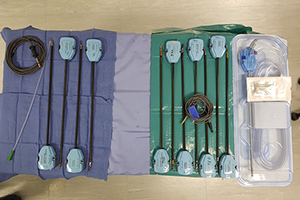Working towards clinical effectiveness—a multi-disciplinary approach to robotic surgery
Abstract
The importance of a multi-disciplinary team (MDT) approach to conventional surgical techniques has strong empirical support. The MDT approach to robotic-assisted surgery (RAS) has not been clearly defined, which encourages prospectively poor MDT performance. Poor performance of the MDT approach, allied to the constant evolution of technology-assisted surgery, can generate unacceptable operative and patient outcomes. This review offers a nursing perspective to the complex paradigm of thoracic RAS, demonstrating key indicators to perioperative MDT engagement. This will be achieved by offering a rationale for RAS in pulmonary resection, identifying additional surgeries where utility is demonstrated. Evaluation of the available evidence will synthesize clinical quality indicators, while key strategies in effective MDT development can be summarised. Conclusively, bespoke and experiential knowledge will be shared, based upon the investigatory findings discussed throughout this article. Allied to a recommended developmental framework, this perspective should allow for transfer of knowledge, creation and replication of useful interventions. Lung cancer is an ever-increasing global concern, currently being the co-modal cancer with an estimated 2.09 million cases worldwide. Populations are ageing and with annual global costs of at least $1.16 trillion, effective treatments are required. RAS shows promise in treating large and complex lesions when compared to a video-assisted thoracoscopic surgery (VATS) approach. A critical indicator being enhanced vision and dexterity in comparison to a VATS approach. Economically, RAS has proven to be an expensive technique, however, when initial purchase costs are excluded, intra-operatively, there are ways to narrow the expense gap and make RAS cheaper. When assessing per hospital stay, exclusive of initial purchase cost, RAS is found to be cheaper than open thoracotomy. This article demonstrates that RAS for pulmonary resection has utility for complex lesions where a VATS approach would be unsuitable. Crucially, as with all complex surgery, the MDT must be performed effectively for optimum patient outcomes.
Cover






